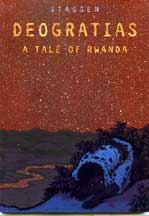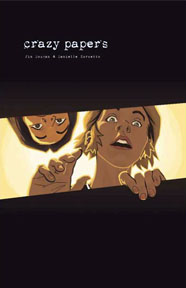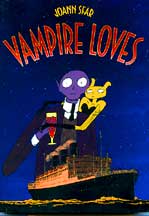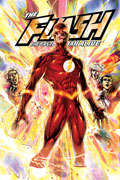A Good Start to the Adventures of Jack
By Mark Wheaton
 “Life is a giant, coagulated bowl of suck.” – Jack
“Life is a giant, coagulated bowl of suck.” – Jack
“Fables” is an acquired taste. Anyone who reads the earliest trades and stops will regret it as the first couple of arcs really feel like the first few episodes of a network television series – writer Bill Willingham and artists Lan Medina and then Mark Buckingham were still setting up the world, laying out the rules and letting the readers get a feel for the characters before dropping them down the rabbit’s hole (wooden soldiers, anybody?) and seeing just how far down it goes.
And just like that fabled White Rabbit, it goes pretty deep.
Now, one of the side characters – Jack Horner, the Jack of all fairy tales – has his own book after being banished for creating movie studios and making millions on promoting himself as he knows that the more the masses believe in you, the more powerful you become. Of course, “Jack of Fables” begins a few hours after he was kicked out and now has only a suitcase of money to his name – which he completely loses by the mid-point of issue #1.
Seems that Willingham and co-author Matthew Sturges will for now be keeping Jack in a “The Prisoner”-esque location called The Golden Boughs Retirement Home where a group calling themselves the Librarians are holding trapped Fables – many of which have so faded from the public imagination that they’re virtually powerless. With such an interesting world to explore, who needs more? But then, on the last page ***SPOILER WARNING*** we’re introduced to Jack’s buck naked, wannabe bed-mate, Goldilocks. So that’s where she’s been after wreaking so much havoc early on. ***END SPOILERS***
As Jack’s t-shirt on the cover suggests (“Ensemble Books are for Losers”), “Jack of Fables” is an interesting new turning point that looks to streamline the sometimes over-crowded universe of “Fables,” focusing on one of its more clever and devious rogues. Would this have world with Bigby or Prince Charming? Maybe, but having a scoundrel like Jack out in the world is pretty intriguing and they’ve certainly kicked off the series with the right tone.
Here’s hoping they keep it up.
RATING: 
By Graig
 You’ve seen this before in movies like the Transporter, or on the internet in BMW’s The Hire series of short films, TV shows like Knight Rider or Dukes of Hazzard, or even in video games like Driver and to some extent, Grand Theft Auto. There’s this dude, he has a car, he drives it well, he takes jobs that utilize his skill, action ensues.
You’ve seen this before in movies like the Transporter, or on the internet in BMW’s The Hire series of short films, TV shows like Knight Rider or Dukes of Hazzard, or even in video games like Driver and to some extent, Grand Theft Auto. There’s this dude, he has a car, he drives it well, he takes jobs that utilize his skill, action ensues.
So the formula goes and again remains unmodified in Chuck Dixon’s and Timothy Green II’s new six-issue mini-series
In the first issue of Rush City, Rush takes on a case to find a missing girl, driving hijinks and busting down doors are the order of the day, and Rush inadvertently stumbles upon a criminal underworld that even he doesn’t yet understand.
It’s not brilliance incarnate, but like most of Chuck Dixon’s work, it’s high octane, easily digestible and forgettable entertainment. The dialogue isn’t particularly snappy, nor unbearably expository, it’s just there moving the story along. Tim Green II’s European-influenced artwork is an interesting choice for the series, but he knows how to construct a mean action sequence: whether it’s a car barrelling down a subway stairwell or Rush taking out a couple of stooges in the dark (they were warned to never enter the darkness with him), Green draws it damn well. There’s almost a defeated purpose to the book though, since no matter how well Green can compose a frame, automobile action sequences really don’t have that much of an impact on a comics page. I think the episodic capabilities of the character would make for a fun tv show, as it does make for an entertaining, but not overwhelming, comic.
RATING: 
Justice League of
By Graig
 For well over 50 years Superman, Batman and Wonder Woman have remained the most iconic superheroes in the world, their individual brands holding more cache in the public eye than their publisher’s. They are the founding fathers and mother of superheroics, and though their histories, powers and even characterizations may have gone through changes over the years, their visibility and status has rarely waned. They are the Big Three; every comic book readers and many a Joe Public know this. Despite their association as “the big three”, it’s unusual for the three of them to appear in stories together. Sure, Bats and Supes get together more often than Jack Twist and Ennis Del Mar go “fishing”, and Superman and Wonder Woman trade lip-locks and fisticuffs from time to time, but aside from the occasional Alan Moore or Matt Wagner story over the years the three of them havn’t really been solidified as a trio, not in the way that Black Canary and Greens Lantern and Arrow were anyway.
For well over 50 years Superman, Batman and Wonder Woman have remained the most iconic superheroes in the world, their individual brands holding more cache in the public eye than their publisher’s. They are the founding fathers and mother of superheroics, and though their histories, powers and even characterizations may have gone through changes over the years, their visibility and status has rarely waned. They are the Big Three; every comic book readers and many a Joe Public know this. Despite their association as “the big three”, it’s unusual for the three of them to appear in stories together. Sure, Bats and Supes get together more often than Jack Twist and Ennis Del Mar go “fishing”, and Superman and Wonder Woman trade lip-locks and fisticuffs from time to time, but aside from the occasional Alan Moore or Matt Wagner story over the years the three of them havn’t really been solidified as a trio, not in the way that Black Canary and Greens Lantern and Arrow were anyway.
But Brad Meltzer’s take on the trinity in Justice League of
It’s an interesting and decidedly different take on the JLA than what’s been done in the past. Traditionally the JLA has been a venue to step outside of the Big Three, to have other characters take the spotlight and to show that the DC Universe is so much larger and more powerful than Batman, Superman and Wonder Woman. Meltzer undercuts that idea somewhat, much in the same way that Grant Morrison did by establishing the “big seven” when he relaunched the title a few years back. But by the end of the first year of his run, Morrison had expanded the team to include new reserves, and Meltzer, by the end of Justice League of
As for issue #0, it’s an interesting read, dispensing quickly a great deal of history as well as teasing with a load of tantalizing “future” bits, as well as the occasional side effect of the Infinite Crisis rearing its ugly head in a curious and, no doubt, affecting manner. Surprisingly solid.
RATING: 
![]()

A.L.I.E.E.E.N.
First Second books
By Graig
 What an unusual little book.
What an unusual little book.
The title, A.L.I.E.E.E.N. is an acronym, standing for Archives of Lost Issues and Earthly Editions of Extraterrestrial Novelties. The idea with this original graphic novel is that creator Lewis Trondheim stumbled across an alien comic book in the forest one day and is presenting it here for all to see. And what there is to see is a bizarre kaleidoscope of cute Ugly Doll-style creatures inhabiting a colorful landscape full of pointy trees that take out the eyes of careless beings, clans of aliens intolerant of those different from them, and a thing that apparently has a black hole inside it, dispensing from it an unlimited stream of poop (kind of like a light cycle in Tron).
Despite it’s bubbly, colourful characters, A.L.I.E.E.E.N. is not for kids. At all. In fact I’m fairly sure it would be a traumatic experience should a youngster get his/her hands on this book. For the adults, it’s not a humor book, but it’s not taking itself seriously either, and it seems to be free of any point, moral or objective other than just existing, except maybe to say that it’s a cruel and dirty world out there; have fun!
Since it’s completely dialogue free A.L.I.E.E.E.N. is a quick read, and thus can be revisited as often as it takes to understand the rhythm of its storytelling. There’s a devilishly intriguing sense of innocence-crushing that runs throughout the book, the type of humour that tv shows like Aqua Teen Hunger Force or Wonder Showzen use for fuel, and comparatively, Trondheim uses simplistic graphics, and a vibrant color palette as contrast to the darker underpinnings. I can’t say it’s an enjoyable book, but it’s curiously fascinating.
RATING: 
Deogratias, A Tale Of
First Second
By
 Genocide is a word coined during the latter half of the twentieth century but describes activities that has recurred on a regular basis throughout history, on every continent, by all peoples. This dark side of humanity carries with it a strange fascination. Why is it done? How can one group bring themselves to slaughter another?
Genocide is a word coined during the latter half of the twentieth century but describes activities that has recurred on a regular basis throughout history, on every continent, by all peoples. This dark side of humanity carries with it a strange fascination. Why is it done? How can one group bring themselves to slaughter another?
In 1994 a small east African country,
L.P. Stassen is the writer/artist of this volume, which is translated and introduced by Alexis Siegel. His name is important as the lengthy introduction sets a tone which continues through the actual comic. Both give short shrift to what existed in pre-colonial times. As is popular with many of today’s intelligentsia, this book places most of the blame for any present ills on colonial influence. The introduction and portions of the story lead one to consider the evil Europeans as the source for the outbreak of horror and give little insight into a society and culture
that can bring itself to hack to death enough people so that the dumping of their bodies clogs the flow of a river. This story of a young man driven mad by what he has seen and done certainly illuminates a portion of what happened, but seems incomplete.
L.P. Stassen is a Belgian born artist, now living with his family in
RATING: 
Crazy Papers
Chatterbox Comics
By
 To the 20-something guy who, last week, ran and hid behind a tree after a homeless Black guy asked you for a cigarette, it’s ok. We dealt with it. Your safety comes first. Never mind, us who had to be inconvenienced by telling the guy, “No, I don’t smoke.” You were in danger. That’s all that matters. To the 20-something lady who walked away from that guy as he tried to justify his actions only to you, while making his way from behind the tree after the “danger” had passed, I say this to you: “Thank you. Thank you for not suffering fools gladly of any kind in
To the 20-something guy who, last week, ran and hid behind a tree after a homeless Black guy asked you for a cigarette, it’s ok. We dealt with it. Your safety comes first. Never mind, us who had to be inconvenienced by telling the guy, “No, I don’t smoke.” You were in danger. That’s all that matters. To the 20-something lady who walked away from that guy as he tried to justify his actions only to you, while making his way from behind the tree after the “danger” had passed, I say this to you: “Thank you. Thank you for not suffering fools gladly of any kind in
Writer Jim Dougan’s dialogue is fast-paced and thoroughly enjoyable, wonderfully encompassing the many voices of today’s “urban” women. Dougan’s D.C. is a place where things wonderfully random can and do happen on a regular basis. This is the D.C. I grew up in. This is the DC that I love. I’m looking forward to more from this first time comics author. Artist Danielle Corsetto (Girls with Slingshots) perfectly compliments Dougan’s writing with an art style brimming over with fun.
With strong vibrant characters and wonderful art and writing, Crazy Papers perfectly captures that wonderful transition between college aged “Whoo-girl!” and late 20’s career “Whoa-girl.” Crazy Papers is due for release in your local comic shop in September. To learn more about it, visit chatterboxcomix.com.
RATING: 
![]()

 Vampire Loves (First Second) – Joann Sfar, a French artist, has created over 100 books since 1990. This volume contains four stories of the interpersonal relationships between various supernatural creatures but centers on Ferdinand the vampire. These relationships clearly reflect either Sfar’s own personal dealings with friends and lovers or that of people he ihas closely observed. The artwork has its appeal and the stories are readable, but one cannot but wonder what is added by the inclusion of the otherworldly. Vampires, tree people, minotaurs, werewolves, and the invisible man mingle and flirt to no more purpose than would ordinary people. That the actions reflect real world events creates within the reader an itch to move these stories into the world where they actually occur. Unfortunately it is an itch that cannot be scratched. –
Vampire Loves (First Second) – Joann Sfar, a French artist, has created over 100 books since 1990. This volume contains four stories of the interpersonal relationships between various supernatural creatures but centers on Ferdinand the vampire. These relationships clearly reflect either Sfar’s own personal dealings with friends and lovers or that of people he ihas closely observed. The artwork has its appeal and the stories are readable, but one cannot but wonder what is added by the inclusion of the otherworldly. Vampires, tree people, minotaurs, werewolves, and the invisible man mingle and flirt to no more purpose than would ordinary people. That the actions reflect real world events creates within the reader an itch to move these stories into the world where they actually occur. Unfortunately it is an itch that cannot be scratched. –
RATING: 
 The Flash: The Fastest Man Alive #2 (DC) – like Blaire, Jo, Tootie and Natalie, you too have to take the good and the bad together, it’s a fact of life. Although, in this life you can choose whether or not you want to continue paying money for a comic book that is in equal parts good and bad, deciding if your allegiance to a character is worth your $2.99 every month. This second issue of the new Flash is extremely divisive, as, despite my affinity for Wally West, I can get 100% behind the idea of Bart Allen (formerly Impulse and Kid Flash) taking the reigns of the scarlet speedster. Writers Danny Bilson and Paul De Meo (creators of the 1990 one-season wonder Flash TV show) have a definite grasp on the legacy of the Flash, all the way back from Jay Garrick and Max Murcury, flashing forward to the far future where Bart was born. If they were writing the bible of the Flash, I think it would be a neat read. But Bilson and De Meo seem to be at a loss about what to do with Bart in the modern day. It’s not that they don’t know how they want his character to behave (a brooding, disenfranchised post-teen), but they just have no concept how to add adventure to the character’s drama. In this second issue we discover that Bart is containing the Speed Force inside him, and an eruption of it has now given his best friend super powers. Of course, his friend has never heard of Uncle Ben’s “with great powers…” mantra, and will no doubt be a huge thorn in Bart’s side. Yawn. The art by Ken Lashley is a horrible match for the character, and only serves to drag the book down more. –Graig–
The Flash: The Fastest Man Alive #2 (DC) – like Blaire, Jo, Tootie and Natalie, you too have to take the good and the bad together, it’s a fact of life. Although, in this life you can choose whether or not you want to continue paying money for a comic book that is in equal parts good and bad, deciding if your allegiance to a character is worth your $2.99 every month. This second issue of the new Flash is extremely divisive, as, despite my affinity for Wally West, I can get 100% behind the idea of Bart Allen (formerly Impulse and Kid Flash) taking the reigns of the scarlet speedster. Writers Danny Bilson and Paul De Meo (creators of the 1990 one-season wonder Flash TV show) have a definite grasp on the legacy of the Flash, all the way back from Jay Garrick and Max Murcury, flashing forward to the far future where Bart was born. If they were writing the bible of the Flash, I think it would be a neat read. But Bilson and De Meo seem to be at a loss about what to do with Bart in the modern day. It’s not that they don’t know how they want his character to behave (a brooding, disenfranchised post-teen), but they just have no concept how to add adventure to the character’s drama. In this second issue we discover that Bart is containing the Speed Force inside him, and an eruption of it has now given his best friend super powers. Of course, his friend has never heard of Uncle Ben’s “with great powers…” mantra, and will no doubt be a huge thorn in Bart’s side. Yawn. The art by Ken Lashley is a horrible match for the character, and only serves to drag the book down more. –Graig–
RATING: 
 Black Panther #18 (Marvel) – So, the most drama in this issue where Storm and Black Panther finally marry comes from a pointless stand-off between “Civil Wars” adversaries Iron Man and Captain America, both of whom are invited to the wedding, both of whom beg off after going toe-to-toe and being threatened by T’Challa in regards to Wakanda’s “neutrality” (though after Cap leaves, it’s never explained why Tony Stark doesn’t just stay – despite him telling T’Challa that he’d best “step in line” with the new order and storming off). Humorously covered by BET – the network “Panther” scribe Reginald Hudlin is President of Production for – the wedding goes off without a hitch, though Storm has to be given the once-over by the Panther God first. The coolest moment comes in the opening of the presents where Dr. Doom invites the two of them to Latveria to discuss the new post-House of M world. Could the next few issues be a cool, European adventure pitting the Panther against Dr. Doom? Let’s hope so. Enough of this wedding hoo-ha. –Mark
Black Panther #18 (Marvel) – So, the most drama in this issue where Storm and Black Panther finally marry comes from a pointless stand-off between “Civil Wars” adversaries Iron Man and Captain America, both of whom are invited to the wedding, both of whom beg off after going toe-to-toe and being threatened by T’Challa in regards to Wakanda’s “neutrality” (though after Cap leaves, it’s never explained why Tony Stark doesn’t just stay – despite him telling T’Challa that he’d best “step in line” with the new order and storming off). Humorously covered by BET – the network “Panther” scribe Reginald Hudlin is President of Production for – the wedding goes off without a hitch, though Storm has to be given the once-over by the Panther God first. The coolest moment comes in the opening of the presents where Dr. Doom invites the two of them to Latveria to discuss the new post-House of M world. Could the next few issues be a cool, European adventure pitting the Panther against Dr. Doom? Let’s hope so. Enough of this wedding hoo-ha. –Mark
RATING: 
 Corporate Ninja #3 (Slave Labor Graphics) – Uh oh. A Microsoft analog has created a new internet browser that takes a vested interest in its user, to the point where it watches out for the user’s health, and decides that the internet is making society lazy and fat. So the browser, mighty and strong, starts systematically shutting down the internet. That can’t be good for business. How is the company going to solve this crisis? Call up the Corporate Ninja, of course. The Ninja, using a special ninja technique, digitizes himself Tron-like and enters the virtual realm where he must encounter all the crazy facets the ‘net has to offer, such as web surfing, annoying pop-ups and, yes, porn! Sweet ninja lovin, it’s another crazy, absurd, and satirical production from Matt Mocarski, whose cartooning gets stronger by leaps with every issue. –Graig–
Corporate Ninja #3 (Slave Labor Graphics) – Uh oh. A Microsoft analog has created a new internet browser that takes a vested interest in its user, to the point where it watches out for the user’s health, and decides that the internet is making society lazy and fat. So the browser, mighty and strong, starts systematically shutting down the internet. That can’t be good for business. How is the company going to solve this crisis? Call up the Corporate Ninja, of course. The Ninja, using a special ninja technique, digitizes himself Tron-like and enters the virtual realm where he must encounter all the crazy facets the ‘net has to offer, such as web surfing, annoying pop-ups and, yes, porn! Sweet ninja lovin, it’s another crazy, absurd, and satirical production from Matt Mocarski, whose cartooning gets stronger by leaps with every issue. –Graig–
RATING: 